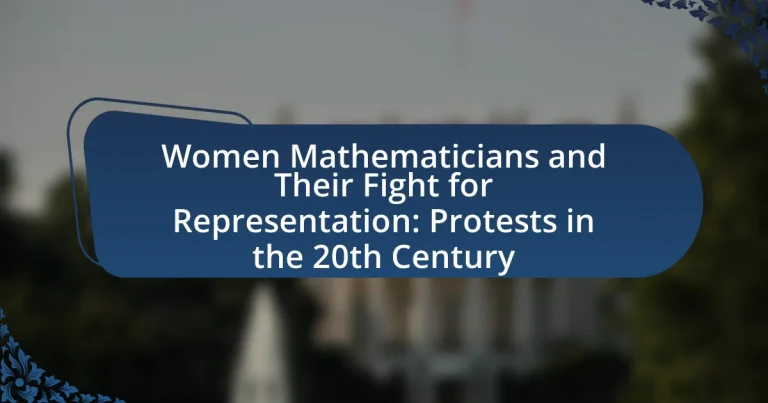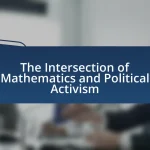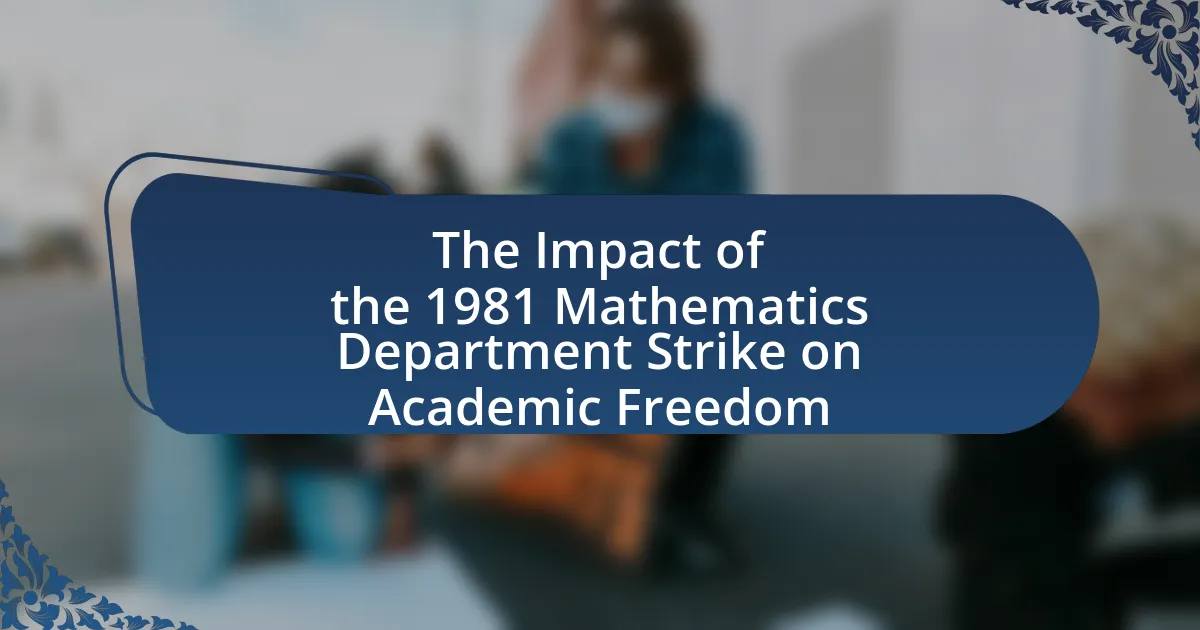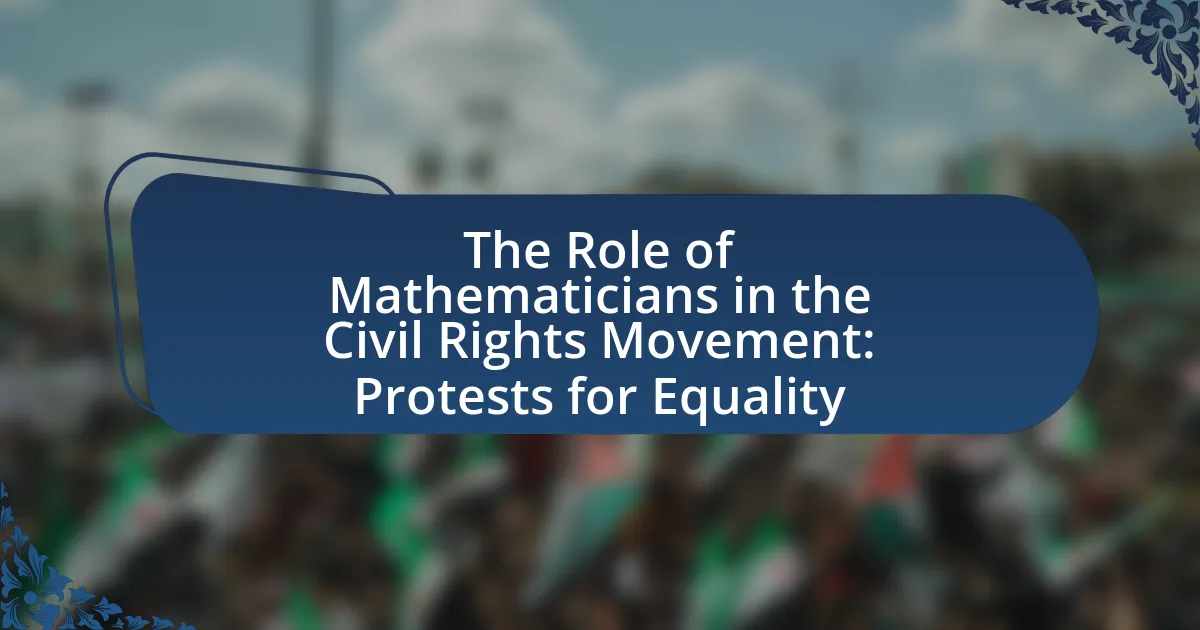The article examines the challenges faced by women mathematicians in the 20th century, highlighting systemic discrimination, limited educational access, and societal biases that hindered their contributions to the field. It discusses the impact of stereotypes on women’s participation in mathematics, the institutional barriers they encountered, and the role of universities in restricting access. The article also details key protests and movements, such as the formation of the Association for Women in Mathematics, which aimed to advocate for representation and inclusivity. Furthermore, it explores the long-term effects of these movements on women’s representation in mathematics and outlines current initiatives and best practices to support women in the field today.
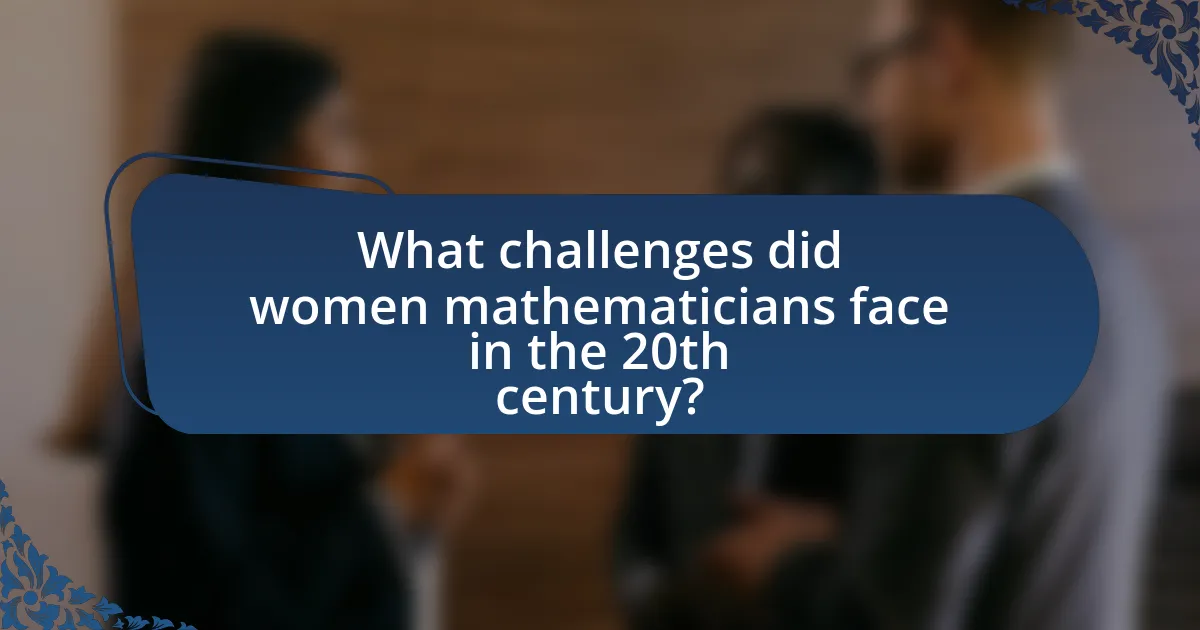
What challenges did women mathematicians face in the 20th century?
Women mathematicians in the 20th century faced significant challenges, including systemic discrimination, limited access to education and professional opportunities, and societal biases that undermined their contributions. For instance, many universities and academic institutions had policies that explicitly barred women from enrolling in mathematics programs or restricted their participation in research. The American Mathematical Society reported in the 1970s that women constituted only about 5% of the mathematics workforce, highlighting the stark underrepresentation. Additionally, women often encountered a lack of mentorship and support, which further hindered their career advancement. These barriers were compounded by cultural stereotypes that questioned women’s capabilities in mathematics, leading to a pervasive environment of exclusion and marginalization.
How did societal attitudes impact women’s participation in mathematics?
Societal attitudes significantly hindered women’s participation in mathematics by perpetuating stereotypes that deemed mathematics as a male-dominated field. Historically, women were often discouraged from pursuing mathematics due to beliefs that they lacked the intellectual capacity for such disciplines. For instance, in the early 20th century, educational institutions frequently reinforced these stereotypes, leading to lower enrollment rates of women in mathematics courses. Additionally, societal expectations regarding gender roles further marginalized women, limiting their opportunities for advancement in mathematical careers. Research by the American Mathematical Society indicates that women constituted only about 10% of mathematics PhDs awarded in the 1970s, reflecting the impact of these societal attitudes on their representation in the field.
What stereotypes existed about women in mathematics?
Stereotypes about women in mathematics included the belief that women were inherently less capable in mathematical reasoning and problem-solving compared to men. This perception was reinforced by historical biases and societal norms that discouraged women from pursuing mathematics as a field of study or profession. Research indicates that these stereotypes were prevalent in educational settings, where girls were often underestimated in their mathematical abilities, leading to lower expectations from teachers and peers. For instance, studies have shown that girls were frequently steered towards less challenging subjects, perpetuating the notion that mathematics was a male domain.
How did these stereotypes affect women’s educational opportunities?
Stereotypes about women’s capabilities in mathematics and science significantly limited their educational opportunities. These stereotypes led to societal beliefs that women were less suited for rigorous academic pursuits, resulting in fewer resources and support for their education. For instance, during the 20th century, women were often discouraged from pursuing higher education in mathematics, with only 27% of mathematics degrees awarded to women in the 1970s, reflecting the pervasive belief that these fields were predominantly male domains. This systemic bias not only restricted women’s access to advanced studies but also contributed to a lack of female role models in mathematics, further perpetuating the cycle of underrepresentation and discouragement.
What institutional barriers hindered women mathematicians?
Institutional barriers that hindered women mathematicians included discriminatory hiring practices, lack of access to mentorship, and limited funding opportunities. Discriminatory hiring practices often favored male candidates, resulting in fewer women being hired for academic positions. Additionally, the absence of mentorship programs specifically for women meant that they had less guidance and support in navigating their careers. Limited funding opportunities further restricted women’s ability to conduct research and participate in conferences, which are crucial for professional development. These barriers collectively contributed to the underrepresentation of women in the field of mathematics throughout the 20th century.
What role did universities play in limiting women’s access to mathematics?
Universities played a significant role in limiting women’s access to mathematics by implementing policies and cultural practices that favored male students. Historically, many universities restricted women’s enrollment in mathematics programs, often citing beliefs about women’s intellectual capabilities. For instance, in the late 19th and early 20th centuries, institutions like Harvard and MIT did not admit women to their mathematics departments, effectively barring them from advanced study and professional opportunities in the field. Additionally, societal norms and biases within academic environments perpetuated the idea that mathematics was a male-dominated discipline, discouraging women from pursuing it. This systemic exclusion contributed to the underrepresentation of women in mathematics and related fields, as evidenced by the low percentage of female mathematicians in academia during that era.
How did professional organizations respond to women’s participation?
Professional organizations often responded to women’s participation by implementing policies aimed at increasing inclusivity and representation. For instance, many organizations established committees focused on women’s issues and created mentorship programs to support female mathematicians. The American Mathematical Society, for example, initiated programs in the late 20th century to address gender disparities, which included hosting conferences specifically for women in mathematics. These actions were driven by the recognition of the underrepresentation of women in the field and the need to foster an environment conducive to their professional growth.
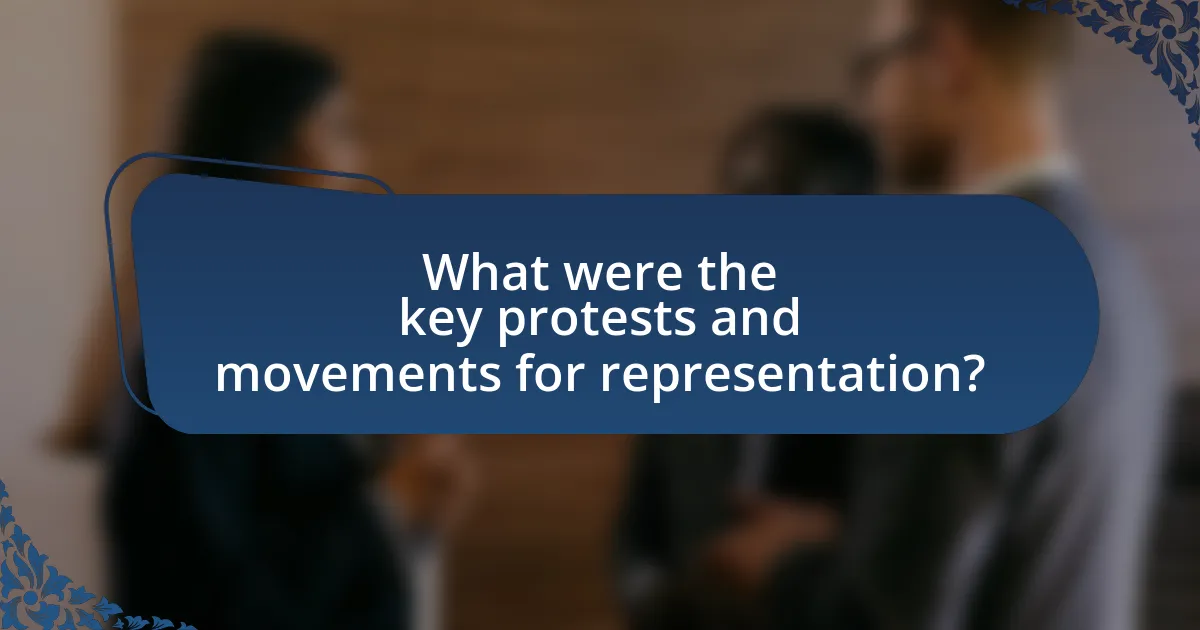
What were the key protests and movements for representation?
Key protests and movements for representation among women mathematicians in the 20th century included the establishment of organizations like the Association for Women in Mathematics (AWM) in 1971, which aimed to promote the participation of women in mathematics and address gender disparities. Additionally, the 1970s saw significant activism surrounding the inclusion of women in academic mathematics, highlighted by protests at conferences and universities advocating for equal opportunities and recognition. These movements were fueled by the broader feminist movement, which sought to challenge systemic inequalities in various fields, including STEM. The impact of these efforts is evidenced by increased visibility and support for women in mathematics, as well as the establishment of scholarships and programs specifically aimed at encouraging female mathematicians.
How did women mathematicians organize for change?
Women mathematicians organized for change through the establishment of professional associations, advocacy groups, and collective actions aimed at increasing representation and addressing gender disparities in the field. Notably, the Association for Women in Mathematics (AWM), founded in 1971, served as a platform for networking, mentorship, and promoting the contributions of women in mathematics. Additionally, women mathematicians participated in protests and campaigns, such as the 1970s “Women in Mathematics” conferences, which highlighted the challenges faced by women in academia and sought to influence policy changes within educational institutions. These organized efforts were crucial in raising awareness and fostering a supportive community that challenged the status quo in a predominantly male-dominated discipline.
What strategies were employed in protests for representation?
Protests for representation by women mathematicians in the 20th century employed strategies such as organized marches, petitions, and public demonstrations to raise awareness and demand equal opportunities. These strategies were often aimed at highlighting the systemic barriers faced by women in mathematics and advocating for policy changes within academic institutions. For instance, the National Organization for Women (NOW), founded in 1966, played a crucial role in mobilizing women mathematicians to advocate for equal representation in educational and professional settings, leading to increased visibility and support for their cause.
Which notable events marked significant moments in the fight for representation?
Notable events that marked significant moments in the fight for representation of women mathematicians include the 1971 formation of the Association for Women in Mathematics (AWM), which aimed to promote the participation of women in mathematics and address gender disparities. Additionally, the 1975 “Women in Mathematics” conference at the University of California, Berkeley, highlighted the challenges faced by women in the field and fostered a network for support and advocacy. These events were pivotal in raising awareness and creating platforms for women mathematicians to voice their concerns and seek equitable representation in academia and professional settings.
What impact did these protests have on the mathematical community?
The protests significantly advanced the representation of women in the mathematical community. These movements raised awareness about gender inequality, leading to increased advocacy for women’s inclusion in academic positions and professional organizations. For instance, the protests in the 1970s and 1980s prompted institutions to implement policies aimed at promoting diversity, such as mentorship programs and equitable hiring practices. As a result, the percentage of women earning mathematics degrees rose from 20% in the 1970s to over 40% by the early 2000s, demonstrating a tangible shift in the demographic landscape of the field.
How did protests influence policy changes in educational institutions?
Protests significantly influenced policy changes in educational institutions by raising awareness about gender inequality and advocating for equitable representation of women in mathematics. For instance, the 1970s protests led by women mathematicians highlighted systemic biases in hiring and promotion practices, prompting institutions to implement affirmative action policies. These actions resulted in increased recruitment of female faculty and the establishment of support networks, as evidenced by the formation of organizations like the Association for Women in Mathematics in 1971, which aimed to address these disparities directly.
What long-term effects did these movements have on women’s representation in mathematics?
The long-term effects of movements advocating for women’s representation in mathematics include increased visibility and participation of women in the field. These movements, particularly during the 20th century, led to significant changes in educational policies and professional opportunities, resulting in a gradual rise in the number of women pursuing mathematics degrees. For instance, the percentage of women earning mathematics degrees in the United States increased from 27% in 1970 to 48% in 2019, according to the National Center for Education Statistics. Additionally, organizations such as the Association for Women in Mathematics were established to support and promote women mathematicians, further solidifying their presence in academia and professional settings.
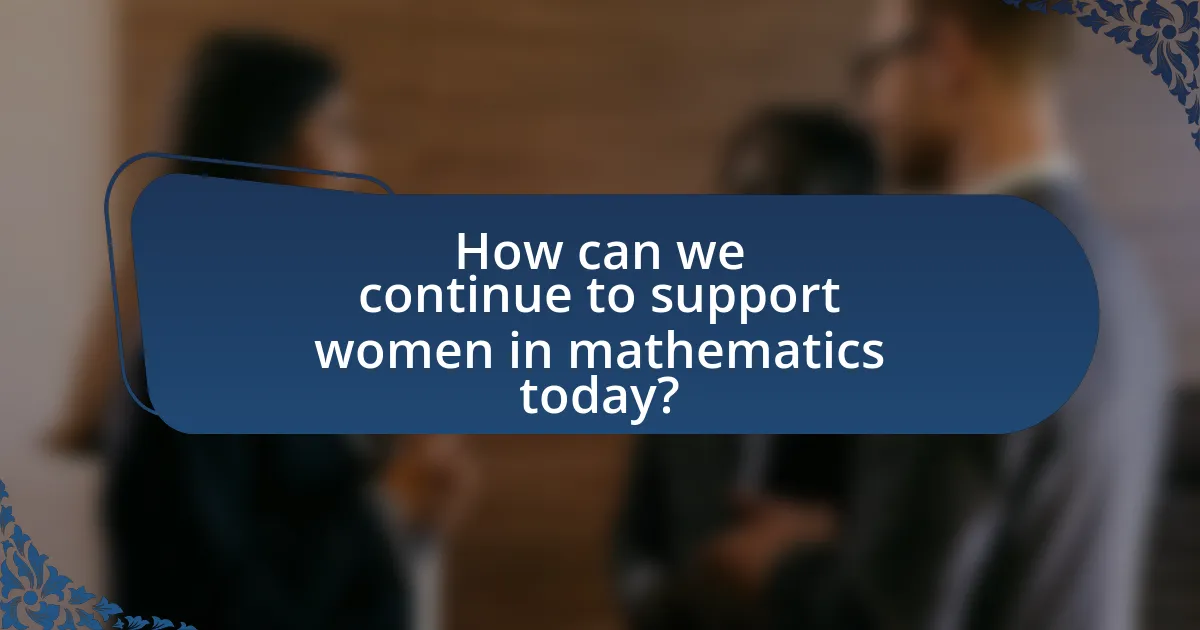
How can we continue to support women in mathematics today?
To continue supporting women in mathematics today, we can implement mentorship programs that connect female students with established women mathematicians. Research shows that mentorship significantly enhances retention and success rates among women in STEM fields. For instance, a study published in the journal “Psychological Science” found that women who had mentors were more likely to pursue advanced degrees in mathematics. Additionally, creating inclusive environments in educational institutions and workplaces fosters a culture that values diversity, which has been shown to improve problem-solving and innovation. Programs that promote visibility of women mathematicians through conferences, publications, and media representation also play a crucial role in inspiring the next generation.
What initiatives exist to promote women in mathematics?
Initiatives to promote women in mathematics include organizations such as the Association for Women in Mathematics (AWM), which provides resources, networking opportunities, and mentorship programs specifically aimed at supporting women in the field. Additionally, the National Science Foundation (NSF) has programs like the ADVANCE initiative, which seeks to increase the participation of women in academic science and engineering, including mathematics. These initiatives are supported by research indicating that diverse teams enhance innovation and problem-solving, thereby reinforcing the importance of promoting women in mathematics.
How do mentorship programs contribute to women’s success in mathematics?
Mentorship programs significantly enhance women’s success in mathematics by providing guidance, support, and networking opportunities. These programs connect women with experienced mentors who can offer personalized advice, share valuable resources, and help navigate academic and professional challenges. Research indicates that women with mentors are more likely to pursue advanced degrees and careers in mathematics, as they receive encouragement and confidence-building feedback. For instance, a study published in the Journal of Women and Minorities in Science and Engineering found that mentorship positively impacts women’s retention in STEM fields, leading to increased participation and success rates.
What role do scholarships play in supporting women mathematicians?
Scholarships play a crucial role in supporting women mathematicians by providing financial assistance that enables them to pursue higher education and research opportunities in mathematics. This financial support helps to alleviate the economic barriers that often deter women from entering or advancing in the field. For instance, studies have shown that women are underrepresented in STEM fields, including mathematics, and scholarships specifically aimed at women can increase their participation rates. According to the National Science Foundation, women earned only 43% of mathematics degrees in 2019, highlighting the need for targeted financial support to encourage more women to pursue this discipline.
What best practices can organizations adopt to foster inclusivity?
Organizations can adopt several best practices to foster inclusivity, such as implementing diversity training programs, establishing mentorship opportunities, and creating inclusive policies. Diversity training programs educate employees about unconscious biases and promote understanding among diverse groups, which can lead to a more inclusive workplace. Establishing mentorship opportunities connects underrepresented individuals with experienced professionals, facilitating career growth and support. Additionally, creating inclusive policies, such as flexible work arrangements and equitable hiring practices, ensures that all employees feel valued and supported. These practices are supported by research indicating that diverse teams perform better and foster innovation, as highlighted in studies by McKinsey & Company, which found that companies in the top quartile for gender diversity on executive teams were 21% more likely to experience above-average profitability.
How can educational institutions create a more supportive environment for women in mathematics?
Educational institutions can create a more supportive environment for women in mathematics by implementing mentorship programs that connect female students with successful women mathematicians. Research indicates that mentorship significantly enhances the academic and professional outcomes for women in STEM fields, as evidenced by a study published in the “Journal of Women and Minorities in Science and Engineering,” which found that women with mentors are more likely to pursue advanced degrees and careers in mathematics. Additionally, institutions should promote inclusive curricula that highlight the contributions of women mathematicians, thereby fostering a sense of belonging and representation. By actively addressing gender biases in classroom settings and providing resources for female students, educational institutions can cultivate a more equitable and supportive atmosphere for women in mathematics.
What actions can individuals take to advocate for women in mathematics?
Individuals can advocate for women in mathematics by actively supporting initiatives that promote gender equity in the field. This includes mentoring female students, participating in organizations that focus on women in STEM, and promoting inclusive curricula that highlight contributions of women mathematicians. Research shows that mentorship significantly increases retention rates of women in mathematics programs, as evidenced by studies from the American Mathematical Society, which found that women with mentors are more likely to pursue advanced degrees. Additionally, individuals can raise awareness about gender disparities in mathematics through social media campaigns and community outreach, fostering a supportive environment that encourages young women to pursue careers in mathematics.
